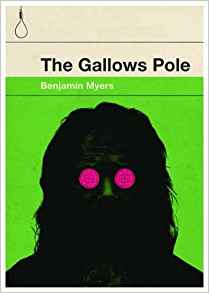The Gallows Pole is a wonderful novel set in 18th Century Yorkshire. It is based on a true story about the Craggs Vale Coiners. Coiners clipped coins. If you look at your £1 coin, you will see the rim is serrated. This is due to the age old crime of clipping. Back in the day, silver and gold coins were actually made of the precious metal. Coiners were engaged in slightly clipping the edges off, melting the scrapings and re-pressing coins. These would then be circulated. Nowadays, the Bank of England promises the bearer of the note, the worth. This is set to the amount of gold the bank has (But not really. Try turning up at the Bank of England with your crumpled fiver, and ask for your gold. You would probably spend the night down the cells). Then, the value of the coin was in its weight in gold. Therefore, clipping devalued the currency, and undermined the Royal Mint. The ruling classes took this “crime” very seriously. As they did forgery of promissory notes. Basically, it undermined the market, and was a threat to the growth of capitalism, and the wealth of the capitalists.
The novel starts in 1767, on the Yorkshire Moors, by Halifax. The back drop to the novel is the rapid industrialisation in the growing cities and towns, and the especially the weaving mills. The main characters in the novel, the coiners, were engaged in subsistence farming on small holdings, and making ends meet by hand loom weaving. They were clear about the threat to their communities and lifestyles by the big mill enterprises. One of their major concerns was the loss of freedom. They understood that once they became wage slaves in the mills, their time and lives would be regulated.
Furthermore, the gains made by the coiners were not just spent on beer, tobacco and good living, though some was. They also provided for the community. Children’s feet were shod, widows ate, and the poor were looked after. The coiners were popular, and most people shut up.
The Craggs Vale coiners were a large gang, made up of men from the Moors. These were hard working men, used to working the land, but honest to each other. They had differing roles. Some collected coins from traders, some clipped, and some kept guard. The main man was David Hartley, or King David as he was referred to as. His strength was renowned, but he was no bully. He was supported by his two brothers, William and Isaac. The gang’s fortunes took a turn for the better, with the arrival of the alchemist. This outsider was brought to the gang. He was a man of few words, but numerous tools and skills. They brought him the coins, and he did the work. The gang member’s prospered, and the community thrived.
In the meantime, in Halifax, the bourgeoises were not so content. A young solicitor, Richard Parker, was determined to bring them down. In between buying up land and filling his pockets, he chased the gang. He used an excise man, William Deighton, to aid him. Deighton was a hated man in the valleys and moors. Closing down stills, and arresting people for taxation misdemeanours. He was an outcast in his community, but he did not care. The downfall of the coining gang, was greed. James Broadbent turned witness, on the promise of 100 guineas, a massive amount for the time. Parker and Deighton had no intention of giving him this money, and treated him with contempt. However, his evidence started the unravelling of the gang. Some informers were caught, and dispatched, and Broadbent, incarcerated himself, had a rough time in jail.
King David eventually paid the full price, but his brothers escaped, as did most of the gang, some after a period of jail. The alchemist disappeared all together, probably to other adventures. Coining did not stop here, the bank had to change the coinage system. Deighton was killed, and Parker prospered. Many people trudged into the mills, and gave themselves up to wage slavery.
I hope I have not given too much away, and you will still read this book. It is a cracking read, a real page turner. Also, it is another story in the class struggle, and some things turned out alright. If you want to know more, then try this:
http://www.yorkshirecoiners.com/
http://www.executedtoday.com/2016/04/28/1770-king-david-hartley-yorkshire-coiner/
but not before you read the book; and tonight raise a glass to King David Hartley. We all know that Robin Hood was probably bollox, but Hartley was the real deal.
In solidarity
Steve Mills
BRHG March 2018





